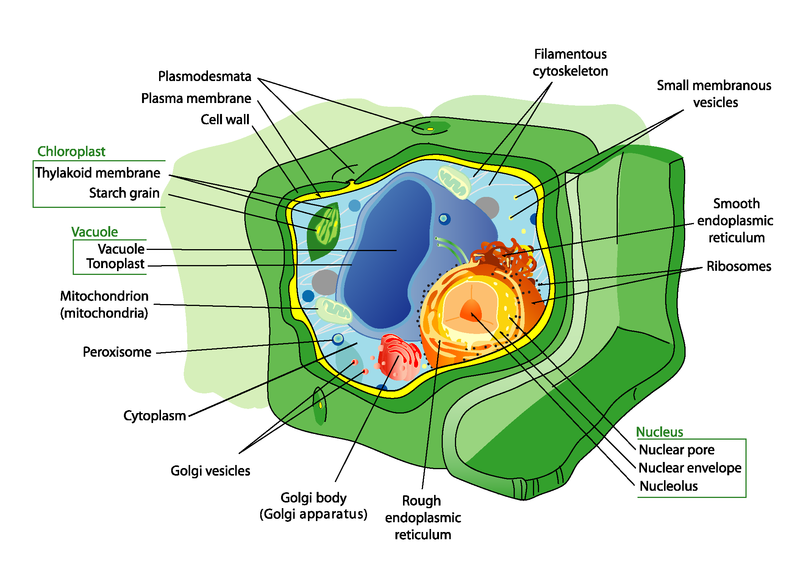Which Best Describes the Structure of a Plant Cell Wall
Which best describes how the cell wall is able to provide shape structure and protection for plant cells. Cell Wall - Plant Anatomy.

Plant Cell Nomenclature Book Plant Cell Cells Project Parts Of A Plant
The plant cell wall is composed of cellulose.

. The outermost covering made mainly of non-living cellulose which gives distinct shape to the cell. Primary wall is about 01 µm thick normally but the walls of collenchyma may be 10 µm thick. It is a thin delicate and elastic covering lying inner to the cell wall.
It separates the nucleus from the cytoplasm. While all plant cells have a middle lamella and primary cell wall not all have a secondary cell wall. The cell wall is.
Structure Functions and. In plants like algae it is composed of cellulose while in other plants it is composed of hemicellulose. Which best explains why the nucleus is important to cells.
Cell wall is a protective covering that can be found on plants fungi and bacteria. Which best describes the function of the cell wall in plant cells. Play this game to review Science.
It is made of a tough carbohydrate called cellulose. A plant cell may consist of either primary wall only or the cell may contain both primary and secondary walls Fig. Step 2 Structure of a plant cell wall The outermost rigid and supportive organ of a plant cell is called the cell wall.
Plant cell walls are primarily made of cellulose which is the most abundant macromolecule on Earth. It usually grows in surface area. Cellulose fibers are long linear polymers of hundreds of glucose molecules.
It is a rigid layer which is composed of cellulose glycoproteins lignin pectin and hemicellulose. It breaks down food particles. When the central vacuole is full of water it applies pressure to the cell wall and maintains the shape of the cell.
The mitochondria and the cell wall sort and package proteins for the cell. 1 The model shows a plant cell. It is made of a tough carbohydrate called cellulose.
The cytoplasm and the cell membrane deliver nutrients around the cell. Thick cellulosic primary cell walls are observed in the endosperm cells of Phoenix dactylifera Strychnos nux-vomica etc. Which organelles are most helpful in distinguishing between plant and animal cells.
The first formed wall of a cell is the primary wall. It is also called cell membrane. Supports the frame of a cell.
Which of the following best describes how the cell wall is different from the cell membrane. The cell wall is the tough and flexible layer of polysaccharides that provides structure support and protection for the cell. A structure found in plant cells but not in animal cells is the a.
Protects the cell and maintains its shape and prevents excessive water uptake. Which best describes the structure of a cells plasma membrane. A plant cell consists of.
It controls the entry and exit of selected molecules and ions and is selectively permeable. Which is best described as the power center for a cell. The cell wall functions in protecting the cell from outside pressure and prevents mechanical and osmotic stress to enter the cell membrane.
Therefore the correct answer is C. The cuticularized epidermal cells may be thicker. Which best describes how the cell wall is able to provide shape structure and protection for plant cells.
A small compartment that includes a cytoplasm a nucleus and a cell membrane. The nucleus contains coded instructions for making proteins. The smallest structural and functional unit of an organism that can be said to be alive.
Thick primary wall in contrast to secondary wall is plastic and reversible. Which statement correctly describes a function of the organelles in this model. A sac-like membrane that stores water.
Proteins sandwiched between two layers of phospholipid. Strong walls of specialized cells hold the. Both the cell membrane and the cell wall act to protect the organelles within a cell.
Which of the following best describes how the central vacuole helps support the structure of a plant cell. The plant cell wall is multi-layered and consists of up to three sections. Cellulose is a structural carbohydrate and is considered a complex sugar because it is used in.
The plant cell wall is an elaborate extracellular matrix that encloses each cell in a plant. The cell wall is the outer covering of a cell present adjacent to the cell membrane which is also called the plasma membrane. It provides tensile strength and maintains integrity of the leaves stem and other parts of the plant.
It was the thick cell walls of cork visible in a primitive microscope that in 1663 enabled Robert Hooke to distinguish and name cells for the first time. Chloroplast and cell wall. -strong wall outside cell membrane of plants fungi prokaryotes and some unicellular eukaryotes.
The mitochondria and chloroplasts are sources of energy for the cell. Just like different organs within the body plant cell structure includes various components known as cell organelles that perform different functions to sustain itself. It is mainly composed of cellulose.
From the outermost layer of the cell wall these layers are identified as the middle lamella primary cell wall and secondary cell wall. Gross Structure of Cell Wall. The central vacuole uses a large rigid membrane to support the shape of the plant cell.
Cellulose Are Found In Plant Cell Wall - 17 images - plant cell structure made of cellulose cellulosic using plants to harvest the sun s energy university of plant cell wall is made up of cellulose plant cells cellular organizations class 8 science. As mentioned earlier the cell wall is present in all plant cells fungi bacteria algae and some archaea.
What Is The Cell Structure Of A Plant Cell Quora

No comments for "Which Best Describes the Structure of a Plant Cell Wall"
Post a Comment